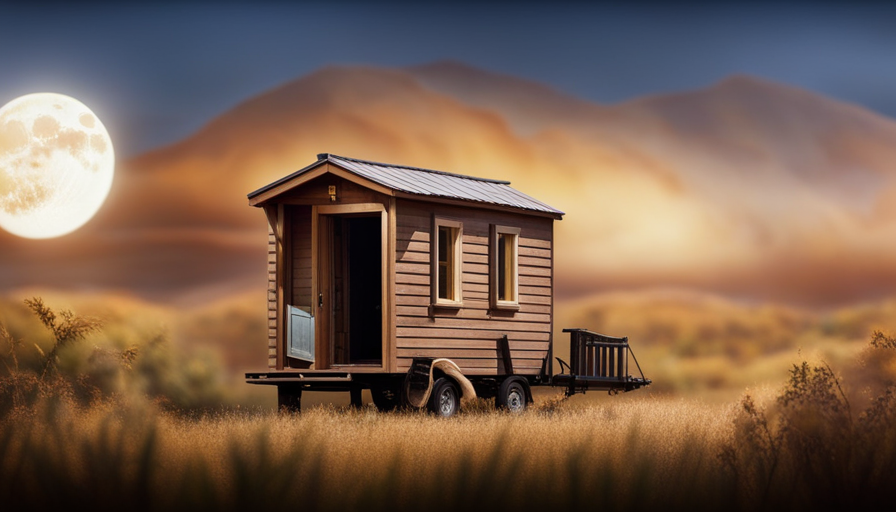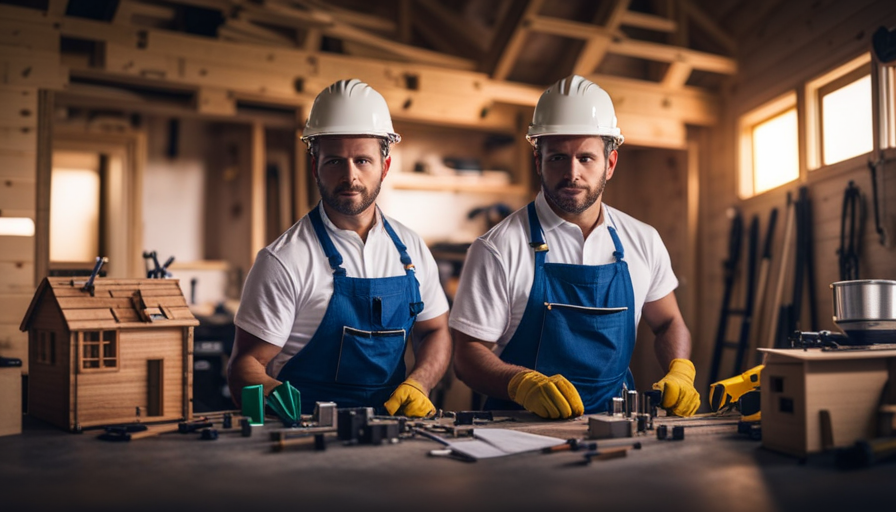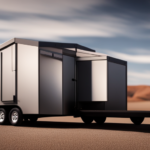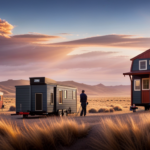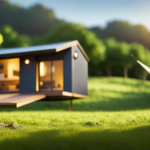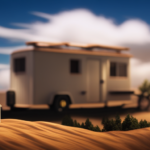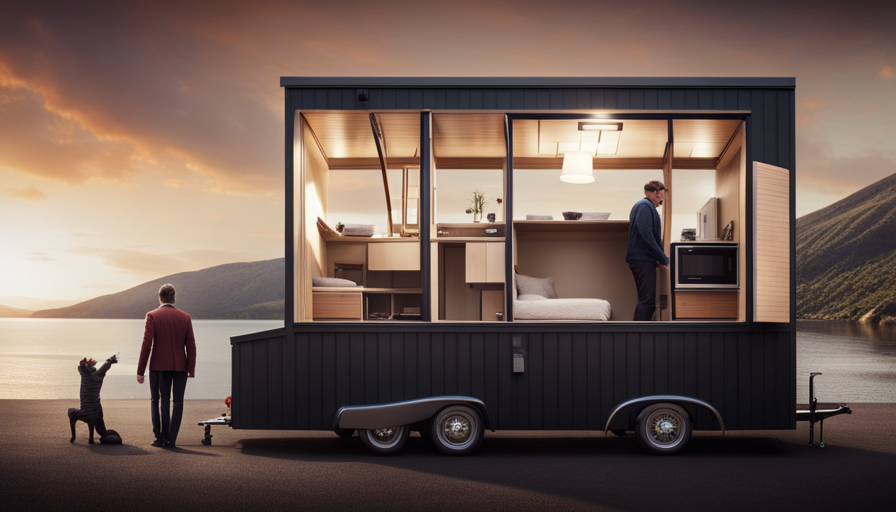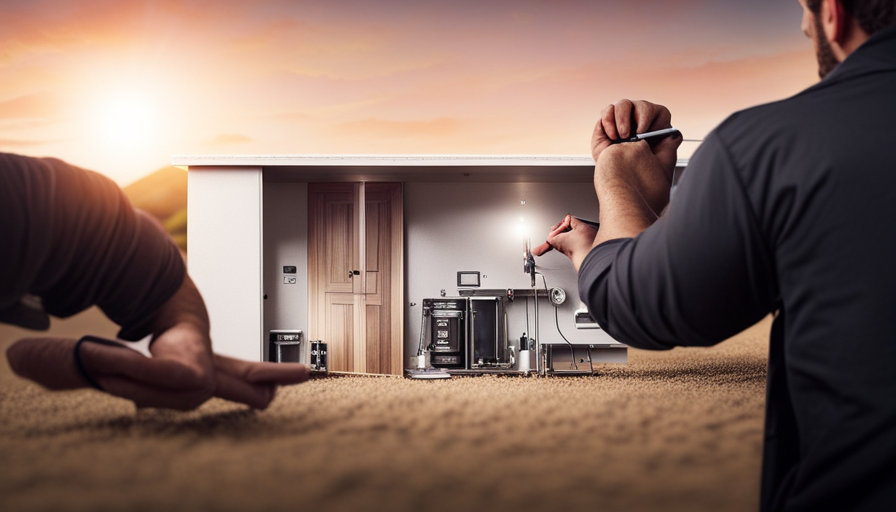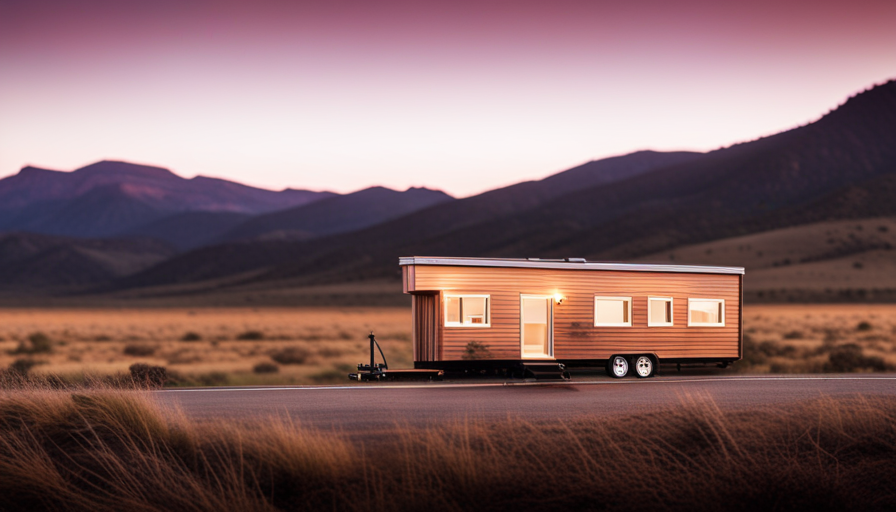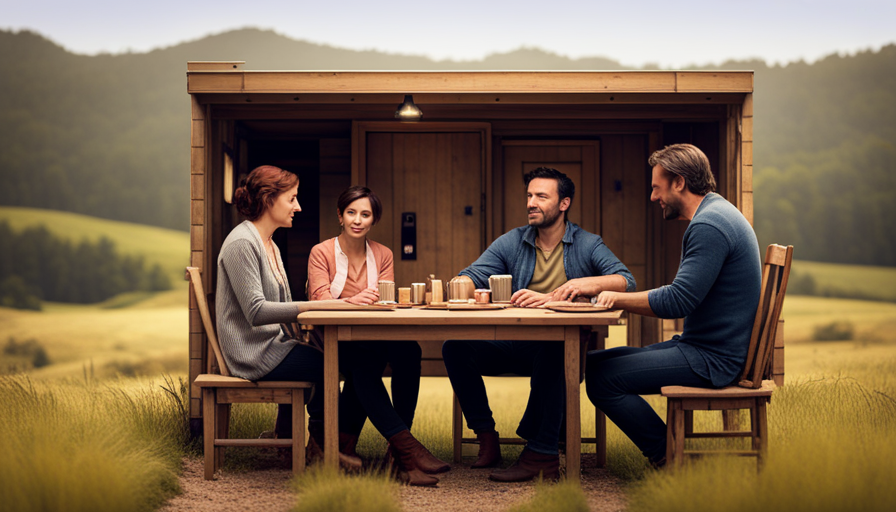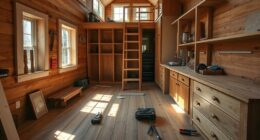Are you interested in learning about how long a Tumbleweed Tiny House can last? Let me share some insights with you. These compact wonders are designed to be long-lasting, thanks to their sturdy construction and high-quality materials. They are built to withstand the test of time.
Picture this: a quaint little house on wheels, perfectly crafted with attention to every detail. It’s a tiny dream come true, and it can be yours. But how long will it last? That’s the burning question on everyone’s mind.
In this article, we will explore the factors that contribute to the longevity of a Tumbleweed Tiny House. We’ll delve into the construction techniques used, the materials chosen, and the maintenance required to keep these tiny abodes in tip-top shape. We’ll also examine how climate, transportation, and lifestyle choices can impact the lifespan of these miniature dwellings.
So, if you’re considering embarking on the tiny house journey, buckle up and get ready to learn everything you need to know about how long a Tumbleweed Tiny House can last. Trust me, you won’t want to miss it.
Key Takeaways
- Tumbleweed Tiny Houses are constructed using sturdy materials and advanced framing techniques, with a foundation reinforced with steel beams and cross members.
- Climate and weather conditions can impact the lifespan of a Tumbleweed Tiny House, with extreme heat, freezing temperatures, heavy rainfall, hurricanes, and heavy snowfall posing potential risks.
- Transportation and mobility of a Tumbleweed Tiny House can be expensive and challenging due to regulations on dimensions and weight, as well as finding long-term parking.
- Tumbleweed Tiny Houses incorporate eco-friendly features such as reclaimed wood, low VOC paints, sustainable energy systems, LED lighting, and high-quality insulation.
Construction and Materials Used
You’ll be amazed at how the high-quality construction and durable materials used in a Tumbleweed tiny house ensure its longevity. Tumbleweed prides itself on using top-notch construction techniques and materials that are built to withstand the test of time.
From the foundation to the roof, every aspect of the construction is carefully designed to maximize durability. The construction of a Tumbleweed tiny house starts with a sturdy trailer foundation. The trailer is reinforced with steel beams and cross members to provide a solid base for the rest of the structure.
The walls are built using advanced framing techniques, which not only make them strong but also help reduce weight. The exterior siding is made of long-lasting materials like cedar or steel, which are resistant to weathering and provide excellent protection.
Inside the tiny house, the floors are constructed using high-quality materials like hardwood or laminate, ensuring they can withstand heavy foot traffic and last for years. The walls are insulated with top-grade insulation, which not only keeps the house comfortable but also helps to prevent any damage that can be caused by moisture.
The construction techniques and durability of materials used in a Tumbleweed tiny house are exceptional. They are specifically chosen to ensure the longevity of the house. However, to maintain the house’s longevity, proper maintenance and upkeep are essential.
Maintenance and Upkeep
Take the time to regularly care for and maintain your Tumbleweed tiny home to ensure its longevity. Proper maintenance is essential for preventing decay and keeping your tiny house in excellent condition. Here are some important tasks to include in your regular maintenance routine:
-
Inspect the exterior: Regularly check for any signs of wear and tear on the exterior of your tiny house. Look for cracks, peeling paint, or loose siding. Address any issues promptly to prevent further damage.
-
Clean the exterior: Keep your tiny house clean by regularly washing the exterior. Use a mild detergent and a soft brush to remove dirt, dust, and grime. This will help maintain the appearance and protect the materials from deterioration.
-
Check the roof: Inspect the roof for any damage or leaks. Look for missing shingles, cracked seals, or any signs of water damage. Repair any issues immediately to prevent water infiltration and potential structural damage.
-
Maintain the windows and doors: Check the windows and doors for proper sealing and functionality. Ensure that they open and close smoothly and that the weather-stripping is intact. Replace any damaged seals or hardware as needed.
Regular exterior maintenance will go a long way in preserving the lifespan of your Tumbleweed tiny house. In the next section, we’ll explore the impact of climate and environment on these homes.
Climate and Environment
When it comes to the lifespan of a Tumbleweed tiny house, climate and weather conditions play a crucial role. Different climates can have varying impacts on the durability and longevity of these small dwellings.
Extreme weather conditions, such as heavy rain, snowstorms, or high winds, can present potential challenges and put additional stress on the structure. It’s important to consider these factors when deciding on the location and maintenance of a Tumbleweed tiny house.
How different climates and weather conditions impact the lifespan
Depending on the climate and weather conditions, a tumbleweed tiny house could either weather the storm like a sturdy oak or wither away like a fragile flower. The effect of temperature plays a crucial role in determining the lifespan of a tiny house. Extreme heat can cause the materials to expand and weaken, leading to structural issues. On the other hand, freezing temperatures can cause the materials to contract and crack, also compromising the integrity of the house.
Additionally, the effect of precipitation cannot be overlooked. Heavy rainfall or prolonged exposure to moisture can result in rot, mold, and decay, causing significant damage to the tiny house over time.
When considering the lifespan of a tumbleweed tiny house, it is important to take into account the climate and weather conditions it will be subjected to. These factors will dictate the level of maintenance and precautions needed to ensure its longevity.
Transitioning into the next section, potential challenges in extreme weather conditions can further impact the durability of a tumbleweed tiny house.
Potential challenges in extreme weather conditions
In extreme weather conditions, the materials in a tumbleweed tiny house may struggle to withstand the elements. Extreme weather challenges such as hurricanes, heavy snowfall, and extreme heat can have a significant impact on the durability of a tiny house. The table below highlights some potential challenges and their impact on the house:
| Extreme Weather Condition | Challenges | Impact on Durability |
|---|---|---|
| Hurricanes | High winds can cause structural damage and roof leaks. | May require repairs or replacement of damaged parts. |
| Heavy Snowfall | Excessive weight can put stress on the structure and cause collapses. | May require reinforcement or removal of snow buildup. |
| Extreme Heat | High temperatures can lead to warping, cracking, and deterioration of materials. | May require replacement of damaged components. |
These challenges highlight the need for careful consideration of weather conditions when choosing a location for a tumbleweed tiny house. Despite these challenges, the mobility of these houses allows for relocation to more suitable climates.
Transportation and Mobility
Transportation and mobility play a crucial role in determining the lifespan of a Tumbleweed tiny house. When it comes to transportation, one of the main considerations is the associated costs. Moving a tiny house from one location to another can be expensive, especially if it requires hiring a professional transport company. Additionally, there may be regulations regarding the dimensions and weight of the tiny house, which can affect the transportation process and incur additional costs.
Parking regulations also come into play when discussing transportation and mobility. Finding a suitable place to park a tiny house can be challenging, as many cities and towns have restrictions on where these homes can be located. Some areas require a permit or have specific zoning laws that limit the options for parking a tiny house. This can make it difficult to find a long-term parking solution, which in turn affects the lifespan of the house.
Transportation costs and parking regulations are important factors to consider when determining the lifespan of a Tumbleweed tiny house. These challenges can impact the mobility of the house and make it more difficult to move or find a suitable parking spot. However, there are other factors that also contribute to the lifespan of a tiny house, such as foundation and anchoring.
Foundation and Anchoring
Finding a solid foundation and secure anchoring is crucial for ensuring the durability and stability of a Tumbleweed tiny house because, let’s face it, no one wants their little abode to become a flying projectile in a strong windstorm.
The foundation stability of a Tumbleweed tiny house is achieved through careful planning and construction. One common method is to use concrete footings or piers to support the weight of the structure. These footings are strategically placed to distribute the load evenly and prevent settling or shifting over time. Additionally, using pressure-treated lumber for the framing and subflooring adds an extra layer of stability and protection against moisture and pests.
When it comes to anchoring techniques, there are several options available. One popular choice is to use steel ground anchors, which are driven into the ground and attached to the tiny house with steel cables or straps. This method provides a strong and secure connection, especially in areas prone to high winds or seismic activity. Another option is to use concrete or helical screw anchors, which are screwed into the ground and provide excellent stability.
Transitioning into the next section about energy efficiency and sustainability, it’s important to note that a solid foundation and secure anchoring are not only essential for stability but also for optimizing energy efficiency. By preventing air leaks and minimizing heat loss, a well-anchored Tumbleweed tiny house can reduce energy consumption and contribute to a more sustainable living environment.
Energy Efficiency and Sustainability
When it comes to energy efficiency and sustainability, the use of eco-friendly materials and systems plays a crucial role. By incorporating features such as solar panels, energy-efficient appliances, and insulation made from recycled materials, Tumbleweed tiny houses are designed to minimize their environmental impact.
Not only do these energy-efficient features contribute to a greener lifestyle, but they also contribute to the longevity of the house by reducing energy consumption and increasing overall durability.
The use of eco-friendly materials and systems
You’ll be amazed at how eco-friendly materials and systems in a Tumbleweed tiny house can significantly extend its lifespan. Tumbleweed uses a variety of eco-friendly building materials that are not only sustainable but also durable.
For example, they utilize reclaimed wood for the flooring, siding, and cabinets, reducing waste and giving new life to old materials. Additionally, they incorporate low VOC (volatile organic compounds) paints and finishes, ensuring a healthier indoor environment.
Tumbleweed also focuses on sustainable energy systems, such as solar panels and rainwater harvesting. These systems not only reduce the environmental impact but also provide long-term cost savings.
By utilizing these eco-friendly materials and systems, Tumbleweed tiny houses are built to last. They withstand the test of time and contribute to a more sustainable future.
Speaking of longevity, let’s explore how energy-efficient features further enhance the lifespan of a Tumbleweed tiny house.
How energy-efficient features contribute to the longevity
Energy-efficient features in a Tumbleweed tiny house, like LED lighting and high-quality insulation, significantly contribute to its longevity. Proper insulation ensures that the house retains heat during cold winters and stays cool during hot summers. This not only provides a comfortable living environment but also reduces the strain on heating and cooling systems, ultimately extending their lifespan.
Additionally, Tumbleweed tiny houses can be equipped with renewable energy sources such as solar panels or wind turbines. These eco-friendly energy solutions not only reduce the environmental impact but also decrease reliance on traditional power grids, promoting sustainability and reducing energy costs. The combination of proper insulation and renewable energy sources creates a more efficient and durable living space.
Transitioning into the subsequent section about proper ventilation and moisture control, these features also play a crucial role in maintaining a healthy indoor environment.
Proper Ventilation and Moisture Control
When it comes to tiny houses, proper ventilation and moisture control are essential to prevent mold, mildew, and moisture-related damages. Good airflow and ventilation systems play a crucial role in maintaining a healthy living environment and preserving the longevity of the tiny house.
It’s important to ensure that the tiny house has adequate ventilation and airflow to remove excess moisture and prevent the buildup of mold and mildew. These can cause structural damage and health issues.
Preventing mold, mildew, and moisture-related damages
To ensure the longevity of your Tumbleweed tiny house, it’s crucial to take preventive measures against mold, mildew, and moisture-related damages. One of the main culprits behind these issues is condensation, which can occur when warm air comes into contact with cooler surfaces.
To prevent condensation, it’s important to implement effective waterproofing techniques. This includes properly sealing all windows and doors, using moisture-resistant materials for construction, and ensuring that all joints and seams are tightly sealed. Additionally, investing in a high-quality ventilation system is essential to promote good airflow and prevent the buildup of moisture.
Good airflow helps to keep the air circulating, reducing the chances of mold and mildew growth. By implementing these preventive measures, you can protect your Tumbleweed tiny house from moisture-related damages and ensure its longevity.
Now, let’s explore the importance of good airflow and ventilation systems.
Importance of good airflow and ventilation systems
Invest in a high-quality ventilation system to ensure good airflow and prevent moisture buildup in your Tumbleweed tiny house. Good airflow is essential for maintaining a healthy and comfortable living environment. It helps to regulate temperature, prevent condensation, and reduce the risk of mold and mildew growth.
With proper ventilation, fresh air can circulate throughout the house, removing stale air and odors. Additionally, good airflow benefits overall indoor air quality by reducing the concentration of pollutants and allergens.
On the other hand, poor ventilation can have detrimental effects. It can lead to excessive moisture, which can cause structural damage and promote the growth of mold and mildew. It can also result in stuffy and uncomfortable living conditions.
To ensure the longevity of your Tumbleweed tiny house, it is crucial to invest in a ventilation system that promotes good airflow. Regular inspections and a maintenance schedule are also important to address any potential issues and ensure optimal performance of the ventilation system. This will help to maintain a healthy and durable living space for years to come.
Now, let’s move on to the next section about regular inspections and maintenance schedules.
Regular Inspections and Maintenance Schedule
Regular inspections and maintenance are essential to ensure the longevity of a Tumbleweed tiny house, so you can relax and enjoy your cozy home for years to come. By following a regular maintenance schedule and conducting inspections at appropriate intervals, you can identify and address any potential issues before they become major problems.
When it comes to regular maintenance, there are several areas that require attention. This includes checking the roof for any leaks or damage, inspecting the plumbing system for leaks or blockages, and ensuring that all electrical components are functioning properly. Additionally, it’s important to inspect the exterior of the house for any signs of wear and tear, such as cracks in the siding or windows. Regularly cleaning and maintaining the HVAC system, including the air filters, is also crucial to ensure good airflow and ventilation.
Inspections should be conducted on a quarterly or biannual basis, depending on the usage and climate conditions. However, it’s recommended to perform a visual inspection of the house every month to ensure there are no obvious issues.
This regular maintenance and inspection routine will help extend the lifespan of your Tumbleweed tiny house and keep it in optimal condition.
By staying proactive with regular inspections and maintenance, you can have peace of mind knowing that your Tumbleweed tiny house is well taken care of. In the next section, we’ll explore how lifestyle and usage can also impact the longevity of your tiny house.
Lifestyle and Usage
Living in a Tumbleweed tiny house is like having a cozy, low-maintenance retreat that feels like a never-ending vacation. The lifestyle benefits of living in a tiny house are numerous. Firstly, it promotes a minimalist lifestyle, allowing you to prioritize experiences over material possessions.
Secondly, it encourages outdoor living, as the small size of the house pushes you to spend more time in nature.
Thirdly, the cost effectiveness of a tiny house is undeniable. The reduced size means lower utility bills and less maintenance, allowing you to save money for other priorities. Additionally, the eco-friendly design of a Tumbleweed tiny house helps you reduce your carbon footprint.
Lastly, the flexibility and mobility of a tiny house allow you to change your scenery whenever you desire, making it easy to explore new places.
Transitioning to the topic of longevity and resale value, it is important to consider how the lifestyle and usage of a Tumbleweed tiny house can impact its overall lifespan and market value.
Longevity and Resale Value
Transitioning to the topic of longevity and resale value, it’s amazing how a Tumbleweed tiny house can retain its charm and allure, becoming a sought-after gem in the real estate market. When it comes to the resale market, these tiny houses have a reputation for holding their value exceptionally well. This is mainly due to their high-quality construction, which ensures their durability over time.
One of the factors that contribute to the long lifespan of a Tumbleweed tiny house is the meticulous attention to detail during the building process. From the sturdy materials used to the skilled craftsmanship, every aspect of these homes is designed to withstand the test of time. This means that even after years of use, a Tumbleweed tiny house will still maintain its structural integrity, making it appealing to potential buyers.
Another advantage of owning a Tumbleweed tiny house is the relatively low maintenance costs. Due to their small size, these homes require less upkeep compared to traditional houses. Additionally, the materials used in their construction are often sustainable and eco-friendly, reducing the need for frequent repairs and replacements.
Tumbleweed tiny houses have a remarkable longevity and resale value in the real estate market. With their high-quality construction and low maintenance costs, these homes can stand the test of time while retaining their charm and allure. Whether you decide to live in it for years or sell it in the future, a Tumbleweed tiny house is a wise investment that will continue to captivate and appeal to potential buyers.
Frequently Asked Questions
Can a Tumbleweed Tiny House be customized or modified to fit my specific needs?
Yes, a Tumbleweed Tiny House can definitely be customized or modified to fit your specific needs. There are various customization options available, allowing you to personalize your tiny house according to your preferences. You can choose from different floor plans, interior finishes, and exterior designs.
Additionally, Tumbleweed offers modifications like adding extra windows, upgrading appliances, or even expanding the size of your tiny house. These options ensure that your Tumbleweed Tiny House meets your unique requirements and desires.
Are Tumbleweed Tiny Houses suitable for year-round living in extreme weather conditions?
In extreme weather conditions, year-round living in a Tumbleweed tiny house can be challenging but not impossible. It requires proper insulation options and regular year-round maintenance. While these houses may not be specifically designed for extreme weather, modifications can be made to improve their suitability.
Anachronism: "Buckle up folks, ’cause I’m about to give you the lowdown on living in a Tumbleweed tiny house all year round in extreme weather conditions."
What are the advantages of choosing a Tumbleweed Tiny House over a traditional RV or mobile home?
Choosing a Tumbleweed Tiny House over a traditional RV or mobile home offers several advantages. Firstly, Tumbleweed Tiny Houses are more affordable, allowing me to save money and live a simpler lifestyle.
Additionally, they are designed with sustainability in mind, using eco-friendly materials and energy-efficient systems. These houses provide a greener living option while still offering the comfort and functionality of a traditional home.
Can I legally park and live in a Tumbleweed Tiny House on my own property?
Yes, it’s generally legal to park and live in a Tumbleweed tiny house on your own property, as long as you comply with zoning regulations. However, these regulations may vary depending on your location, so it’s important to research and understand the specific rules in your area.
Zoning regulations typically address issues such as minimum square footage, setback requirements, and utilities. Consulting with local authorities or a professional can provide further guidance on navigating these regulations.
How does the resale value of a Tumbleweed Tiny House compare to other types of housing?
When comparing the resale value of a Tumbleweed tiny house to other types of housing, it’s important to consider the uniqueness and appeal of these compact dwellings.
While traditional houses may have a broader market, Tumbleweed tiny houses offer a niche market that values minimalism and sustainability.
This can result in a higher resale value compared to other housing types, especially if the tiny house is well-maintained and located in a desirable area.
Conclusion
In conclusion, a Tumbleweed tiny house can last for many years with proper maintenance and care. According to a study conducted by the Tiny Home Industry Association, the average lifespan of a Tumbleweed tiny house is estimated to be around 25 to 30 years.
This is impressive considering their compact size and mobility. With regular inspections, upkeep, and attention to climate and environmental factors, these tiny houses can provide a comfortable and sustainable living space for decades to come.
Whether it’s for a permanent residence or a temporary getaway, investing in a Tumbleweed tiny house is a wise choice for those seeking a long-lasting and eco-friendly housing solution.
Hi, I’m Emma. I’m the Editor in Chief of Tiny House 43, a blog all about tiny houses. While tree houses are often associated with childhood, they can be the perfect adult retreat. They offer a cozy space to relax and unwind, surrounded by nature. And since they’re typically built on stilts or raised platforms, they offer stunning views that traditional homes simply can’t match. If you’re looking for a unique and romantic getaway, a tree house tiny house might just be the perfect option.
